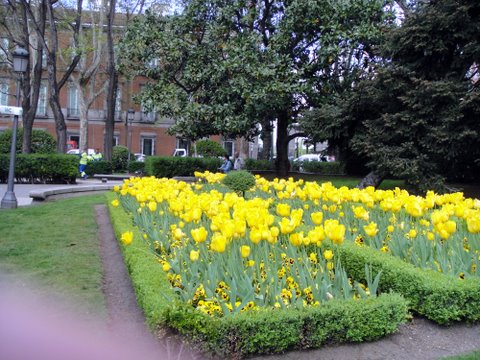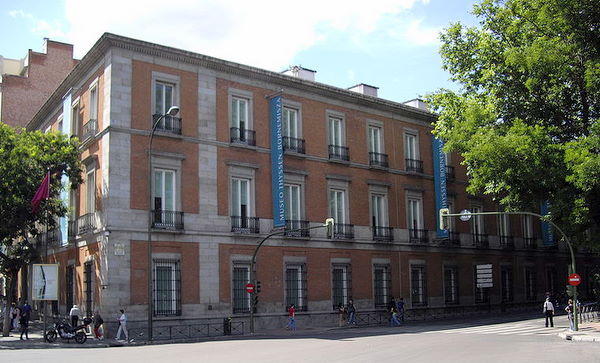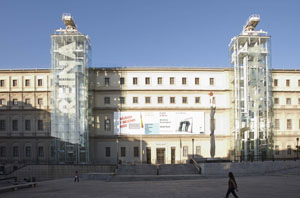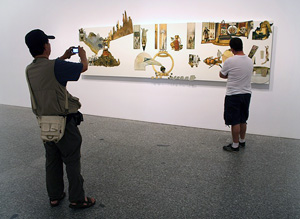Earlier, I wrote about the Prado Museum in Madrid’s Golden Triangle of Art. The Thyssen Bornemisza and the Rein Sofia Museums complete the triangle.
Thyssen Bornemisza Museum
Across the Paseo del Prado from the Prado Museum, a short walk past colorful flower beds takes you to the Thyssen Bornemisza, a museum that opened in 1992 in a former palace. The spacious, light-filled galleries hold hundreds of paintings by El Greco, Velázquez, Dürer, Rembrandt, Watteau, Canaletto, Caravaggio, Hals, Memling, and Goya, among others. It has Gothic 
It started as a private collection by Baron Hans Heinrich Thyssen-Bornemisza. When he married in 1985, his wife Carmen (a former Miss Spain) became interested, and it was her influence that led to the museum opening in Madrid. A $45 million renovation in 2004 created more display space, a top-floor terrace with views over the city, an expanded library, and gardens.

Thyssen-Bornemisza Museum
Tuesday-Saturday, 10 am – 7 pm
Sunday and public holidays, 9 am – 2 pm
Closed Monday
Reina Sofia Museum
Turning back along the Paseo del Prado, past the Prado and Botanical Gardens, you come to the Reina Sofia. This collection of  contemporary art, inaugurated in 1992 by King Carlos and Queen Sofia, holds some fine works of art from the 20th century. The best known is Pablo Picasso’s Guernica. This great painting in blue, black and white, was done in 1937 in response to Germany’s bombing of the Basque town of Guernica, during the Spanish Civil War. It was acclaimed internationally as a symbol of the horrors of war and wish for peace.
contemporary art, inaugurated in 1992 by King Carlos and Queen Sofia, holds some fine works of art from the 20th century. The best known is Pablo Picasso’s Guernica. This great painting in blue, black and white, was done in 1937 in response to Germany’s bombing of the Basque town of Guernica, during the Spanish Civil War. It was acclaimed internationally as a symbol of the horrors of war and wish for peace.
There is much more in the Reina Sofia. From the main plaza, elevators rise in transparent towers to the exhibition rooms where you can marvel at the genius of such famed Spanish artists as Picasso, Juan Gris, Joan Miró, and Licio Munoz. Non-Spanish works are by Robert Delaunay, Man Ray, and Georges Braque, among others.
The museum is in yet another 18th century building, the old General Hospital. In 2005, it was enlarged to encompass 84,000 square meters, making it one of the largest contemporary art museums in the world. It’s more than a gallery. The Reina Sofia  offers numerous education programs for children and has auditoriums and an art library with thousands of books, sound recordings and videos.
offers numerous education programs for children and has auditoriums and an art library with thousands of books, sound recordings and videos.
Reina Sofia Museum
Monday- Saturday, 10 am – 9 pm
Sunday, 10 am – 2:30 pm
Closed Tuesday and December 24, 25 and 31, January 1 and 6, May 1 and 15, September 9, and November 9
Admission can be purchased in advance online or at the door (certain days are free and there are discounts for students and seniors), or buy the Madrid Art Pass, which allows entry to all 3 museums. If you purchase a Madrid Card you’ll gain entrance to some 50 museums and dozens of other Madrid attractions, including the Royal Palace, the zoo, cinema, guided walking tours, an open-air tour bus, and discounts at some restaurants. A Madrid Card costs 45 euros for 24 hours, 58 euros for 48 hours, and 72 euros for 72 hours.


Comments